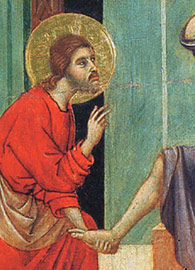John Week 7
Dirty Feet and Discipleship: The Depth of Love: John 13:1–14:31
Seattle Pacific University Assistant Professor of New Testament
Read this week’s Scripture: John 13:1–14:31
16:52
Key Prologue Terms: truth, life, Father/Son, revelation, children of God
Love, Love, Love

 Enlarge
Enlarge
If you watch commercials and storefronts in the U.S. at Valentine’s Day, you might believe that you can develop a recipe for love with three simple ingredients: buy a sweet and/or funny card, add some flowers, and finish it off with some chocolates. The only way for the recipe to go wrong is in terms of time: don’t forget, and don’t be late. As long as you have a card, flowers, and chocolates, at least on Valentine’s Day, you know that you’re showing love, or that you’re loved.
Most of us know that a card, flowers, and chocolates have remarkably little to do with love itself. While these items can help a strong love to grow [Author’s Note 1], they are no substitute for the real thing. This real, sacrificial love is what John 13–14 addresses.
Placing Passover
John 13 marks a significant transition point in the gospel. Chapter 12 concludes with a summary of Jesus’ public ministry (12:44–50), signalling that Jesus has finished revealing God’s nature and character to the people as a whole. The amount of narrative time left in the gospel is very short (chapters 13–20 comprise a little less than four days), even though nearly half of the gospel remains. In other words, chapters 13–21 are primarily focused on preparing Jesus’ disciples, both then and now, to understand Jesus’ glorification — his death, resurrection, and exaltation — in the right light. Furthermore, these chapters also prepare Jesus’ disciples to persevere in his absence.
The overall trajectory of chapters 13–21 seems similar to Matthew, Mark, and Luke: Jesus gathers with his disciples (though they are never numbered in John) at dinner. He offers them some teaching to help them understand his betrayal, denial, and death (this is much longer in John, and significantly different). Then Jesus is arrested, is brought to trial, is crucified, and rises again.
At the beginning of John 13 one difference from the other three gospels stands out. Unlike in the synoptic gospels, Jesus does not celebrate Passover with his disciples. [Author’s Note 2] By not including the institution of the Lord’s Supper (i.e., Passover/Eucharist) [Author’s Note 3] here, John’s gospel can highlight a different way that Jesus demonstrates his love through symbols of sacrifice and death. He washes the disciples’ feet. Washing their feet illustrates his love and self-sacrifice, placing himself in the position of a servant even though he is their Lord (13:13). Jesus illustrates this same self-sacrifice for the world in his death (13:1–2; 15:13).
Washing the disciples’ feet, like the institution of the Lord’s Supper, is an action that points to Jesus’ death and resurrection. However, this particular act allows the community of disciples to participate in the same way that Jesus does. In other words, instead of the community feasting together on Jesus’ broken body and blood, the community, like Jesus, is called upon to wash one another’s feet (13:15–17).
Dirty Feet (13:1–17
Chapter 13 begins with a summary statement by the narrator (13:2). In this statement John’s audience gets a preview of the events that are to come. The next five chapters are framed by Jesus’ knowledge of, and ultimate control over, the events. According to John, Jesus is not taken by surprise or overtaken by force at either his betrayal or his arrest. Instead, he knows it all beforehand.
Moreover, the narrator says, “Having loved his own who were in the world, he loved them to the end” (13:1). The phrase “his own who were in the world” connects back to the prologue of the gospel, where “his own” did not accept him, and yet those who did were called “children of God” (1:10–12). It is to these children of God that the gospel now turns. Furthermore, the italicized phrase in 13:1, “to the end,” can be fruitfully interpreted in two different ways in this chapter. First, Jesus loves his own “to the end,” meaning “to the end of his life,” all the way until his death, resurrection, and exaltation. Second, Jesus loves his own “to the end,” meaning completely and fully, with nothing held back. Both of these meanings are important for the narrative, as Jesus exhorts the same love of his disciples.
Without any preamble of explanation, Jesus gets up from the meal, takes off his robe, and puts on a towel. He begins to wash the disciples’ feet, wiping them with the towel (13:4–5). Because roads were dusty and dirty, it was customary either for a host’s servants to wash guests’ feet or for the guests themselves to do so (cf., e.g., Luke 7:44). It would have been shocking for a host to wash guests’ feet. Jesus washes the feet of his disciples so that they may see how to love one another as he loves them. His ultimate service for them is his death and resurrection; their service to him is to love one another (John 13:14). [Author’s Note 4]
Love, Betrayal, and a Love-Filled Life (13:18–38)
After Jesus washes the disciples’ feet, he predicts that one of them will betray him. In narrating this episode the gospel introduces us to a new character, called either “the disciple whom Jesus loved” or “the beloved disciple” (13:23; see Lectio 6). This character is consistently anonymous. Given that John has freely sprinkled different disciples’ names throughout the gospel narrative — far more liberally than Matthew, Mark, and Luke tend to do — this person’s anonymity seems significant. Essentially it appears that the evangelist asks us to focus on the beloved disciple’s position and relationship with Jesus more than on his own personal identity. In this way it seems that the beloved disciple is presented as a model of discipleship for others. [Author’s Note 5]
This passage notes the beloved disciple’s closeness to Jesus; in fact, he is “reclining next to” Jesus (13:23). Based on this description, Jesus and his disciples were likely eating while reclining on their sides on couches. Often these couches could accommodate two or three people. However, the beloved disciple’s position signals more than simply his proximity or his covetable place at the table. Instead, the phrase translated “reclining next to” is more literally translated “in Jesus’ bosom,” symbolically meaning “close to Jesus’ heart.” This phrase occurs only one other time in John’s gospel, at the beginning: God’s Son is “in the bosom of the Father” (1:18, KJV; NASB). In other words the beloved disciple occupies the same space with respect to Jesus as Jesus does to the Father.
Despite the beloved disciple’s proximity to Jesus, even he does not understand what will happen to Jesus in the coming hours. The prediction of Judas’ betrayal of Jesus must have been more obscure, or simply more unexpected, to the disciples than it is to us. John does include one unusual detail of Jesus’ prediction that Judas will betray him. Fulfilling the prophecy of Psalm 41:9 (see John 13:11), Jesus hands Judas a piece of bread, and at that moment Satan enters Judas (13:27). The point here is not to minimize Judas’ free choice; rather, this serves to emphasize that even Jesus’ betrayer is under Jesus’ control. Furthermore, and perhaps more profoundly, Satan’s entrance into the narrative illuminates the fact that Jesus’ death is about more than just the death of one person. It is about God’s triumph over evil in all its forms, including Satan, on the cross and through Jesus’ resurrection (13:2–3).
Finally, Jesus gives his disciples a “new” commandment in this section: he tells them to “love one another” (13:34). On first glance there is little new about this commandment. Israel’s Torah proclaimed the necessity of loving God and neighbor (see Deuteronomy 6:5; Leviticus 19:18). So the commandment itself is not new; rather, shaping this love according to Jesus’ life, death, and resurrection is. This is not only a love that sacrifices itself in service — in death — for others (John 10:17–18; 13:12–17; 15:13), it is a love whose sacrifice yields new, resurrected life. Such love follows the example of Jesus (13:15), and it is such love that Jesus commands.
Farewell Discourse

 Enlarge
Enlarge
John 14 begins Jesus’ three-chapter monologue, better known as his Farewell Discourse. From this name it is clear that one of the topics of this speech is Jesus’ impending absence. Once Jesus has died, risen from the dead, and been exalted to heaven, he is physically absent from the community of believers. This speech describes what the disciples — the community — are to do in his absence. Furthermore, it describes the Holy Spirit, who serves as Jesus’ perfect substitute for the community. [Author’s Note 6]
Jesus: the Way, the Truth, the Life (14:1–14)
The first main theme of the farewell discourse is Jesus’ words of comfort to his disciples. He repeatedly tells them not to be afraid or to have troubled hearts (14:1). This anxiety may relate back to the predictions of betrayal, denial, and death in John 13, or it may simply relate to concerns about Jesus’ predicted absence. Absence is what Jesus mentions next: he is leaving in order to “prepare a place” for his followers (14:3). This place exists so that Jesus’ followers can continue to abide in him, and he in them (15:1–17): significantly, Jesus’ departure will not prevent their continued relationship with him.
Jesus has repeatedly said that the disciples cannot come with him where he is going (e.g., 13:33). However, here he claims that they do know the way. Thomas understands this literally, as people have been doing throughout the gospel. They do not have a map to get there, nor do they have a destination. Jesus proclaims the figurative interpretation he meant: he himself is “the way, and the truth, and the life” (14:6).
Each of these terms summarizes an important aspect of the Gospel of John. When Jesus declares that he is “the way,” he means what he meant back in John 1. As the Son of Man who has come from heaven and is returning to heaven, he forms a ladder connecting heaven and earth (1:51). Since he reveals God and does the will of God and is God, he is the way to God. This metaphor is parallel to a figure of speech Jesus uses in John 10. There he describes himself as the gate, or the point by which people gain access to life with God. Now he calls himself the way.
Jesus has previously declared that he is truth in that his body is “true food” and his blood is “true drink” (6:55). If disciples “continue in” Jesus’ word, they “will know the truth, and the truth will make [them] free” (8:32). This second passage is clearest in context: truth in 8:32 is synonymous with Jesus, just as it is in 14:6. The fact that Jesus himself is truth makes Pilate’s question, “what is truth?” (18:38), all the more ironic. The reader of the gospel should be able to answer Pilate’s question for him, though Pilate receives no response in the gospel. Jesus could reply, “What is truth? I AM.”
Finally, we have seen many ways in which Jesus embodies the new life in God. If Jesus is “the way” that life with God is provided, he is also “the life” itself that is given. Specifically, Jesus’ claim that he is “the life” here reminds John’s audience of Jesus’ title before he raises Lazarus from the dead: he is “the resurrection and the life” (11:25). However, this title also looks forward to Jesus’ own resurrection, as Jesus will prove to be the life that death can’t overcome.
A Grounded Optimism (14:15–31)
After Jesus’ departure, the Father “will give [Jesus’ followers] another Advocate, to be with [them] forever. This is the Spirit of truth, whom the world cannot receive, because it neither sees him nor knows him” (14:16–17a). The hope that Jesus offers the disciples, including the claim that they will do even “greater works than these” (14:12), is grounded in the coming of the Spirit.
John uses a unique term, or name, for the Holy Spirit. He prefers the term Paraclete, which is a transliteration of the Greek term paraklētos. In 14:16–17 Paraclete is the word translated as “advocate.” It is a legal term that means something like “defense lawyer.” The Paraclete is an advocate for the disciples in a court of law or a trial. At this point a reader of John may recall that Jesus seems to be “on trial” throughout the gospel. He has offered testimony — sometimes on his own behalf, sometimes through the witness of others. He has defended his ministry and his revelation of God to the world. He has not convinced the world, however (14:17) — a point made plain in the gospel (1:10). [Author’s Note 7]
It is significant, however, that John 14:16–17 describes the Paraclete as “another Paraclete,” as though there has already been one. Furthermore, the Paraclete is described as the Spirit of truth, just as Jesus has called himself “the truth” (14:6). The Paraclete also “abides with you” just as Jesus abides with his followers, and they with him (14:17; 15:4). In other words, the Gospel of John describes the Spirit as identical to Jesus, but not in the same bodily form. The disciples can rest — or more precisely, work — in the comfort that the Paraclete brings (14:12–14, 24-26). The presence of Jesus’ peace and life remains with them in his absence (14:27).
Love Lifts Us Up
From foot washing to first discourse, Jesus has demonstrated his love for his disciples. He “love[s] them to the end,” (13:1) meaning that he is going to love them to death — his death, of course. He is also going to love them to life as well. Through his love he will provide the Paraclete to comfort, encourage, and guide the community in his absence.
This love looks little like chocolates, flowers, and cards. Instead, it is a love that lifts disciples up to a community of love between God and Jesus, through Jesus’ death and resurrection. It is a love that not only serves, but serves with a purpose to bring about new life, and new creation, wherever it is. It is a love that sacrifices, knowing the cost of betrayal, but not counting it. It should be the distinguishing mark of a community defined by the one who reveals the very nature of God to us, who shows us that we belong with him (14:3) as his beloved disciples.
Questions for Further Reflection
- Given that we live in a different context than Jesus and his disciples did, do you think Jesus’ command to wash one another’s feet retains the same authority that it did when he gave it? What are modern contexts where it might? What might be substituted for it while still retaining its purpose?
- The Lectio says, “The commandment [to love] is not new; rather, shaping this love according to Jesus’ life, death, and resurrection is. This is not only a love that sacrifices itself in service — in death — for others (10:17–18; 13:12–17; 15:13), it is a love whose sacrifice yields new, resurrected life.” What are tangible ways that you could demonstrate this “love whose sacrifice yields new, resurrected life” to the people in your life?
- Compare the different accounts of Judas’ betrayal in the four gospels (Matthew 26:21–25; Mark 14:18–21; Luke 22:21–23; John 13:21–30). What do you think each gospel writer is trying to communicate?
<<Previous Lectio Back to John Next Lectio>>

This work is licensed under a Creative Commons License.




